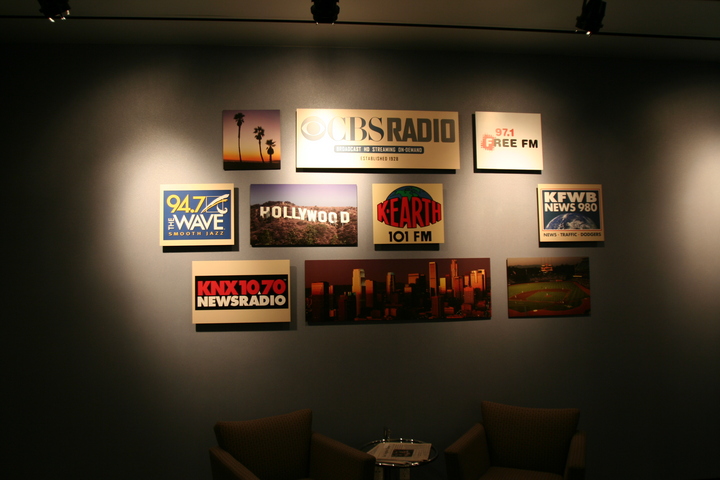
Friday has dawned with typical Southern California sunshine, although we're beginning the morning indoors, at the new CBS Radio studios, 5670 Wilshire Boulevard on L.A.'s “Miracle Mile”. (Isn't it interesting how quickly the “Infinity” name was dropped after the departure of Mel Karmazin? According to our hosts, using the “I word” can now result in disciplinary action.) There's clearly a panel missing from this display, although it's not on the floor behind the chairs (we checked!). There are also two stations missing: KCBS-FM (93.1 Los Angeles) and KROQ-FM (106.7 Pasadena) are still in the old KHJ studios at Venice and Fairfax, and will remain there as a part of CBS's disaster preparedness plan. (Of course, it's KRTH-FM, now here on Wilshire, that has the history at that location, being the former KHJ-FM.)
This facility was completed in late 2005, consolidating the stations from several locations around the city. Tracking the musical studios of the stations in this group is a bit of a challenge with my limited references, but here's what I'm able to come up with:
In 1989, the first year for which I have information, the KROQ-FM studios were on the ninth floor of 3500 West Olive in Burbank—a popular location for studios—not far from the NBC West/KNBC-TV compound on West Alameda. KNX (1070 Los Angeles) and KCBS-FM (93.1 Los Angeles) were both located in the historic Columbia Square facility, 6121 West Sunset, which was also home to KCBS-TV (2 Los Angeles, formerly KNXT) and the L.A. studios of the CBS Radio Network. KFWB (980 Los Angeles) was in its long-time home, a converted supermarket building at 6230 Yucca. KLSX (97.1 Los Angeles) was then co-owned under Greater Media with KRLA (1110 Pasadena) at 3580 Wilshire. KTWV had its own studios at 5746 West Sunset, and KRTH-FM (101.1 Los Angeles)—then still co-owned with AM 930—was at 5901 Venice.
By 1995, with the beginning of deregulation and the duopoly rule, some ownership consolidation had begun: KRTH-FM and KROQ-FM were now commonly owned under the Infinity banner, but still had separate studios. Greater Media still had KRLA and KLSX, and was still at the same Wilshire Boulevard address. Westinghouse had picked up KTWV, but “The Wave” had not moved into ”The Supermarket” (and never would), remaining in its own facility on Sunset. The CBS stations were still in Columbia Square, and KRTH-FM was still at Venice and Fairfax. (Meanwhile, Viacom's 98.7 and 100.3 signals had moved into the same building as KROQ-FM, but on the second floor. 100.3 would later move out in an ownership change, and 98.7 moved down the street in 2003 to the new Clear Channel cluster studios at 3400 West Olive.)
I have a large gap in my reference material between 1995 and 2002, during perhaps the most turbulent period the U.S. radio industry has ever undergone, with the coming of the 1996 Telecommunications Act and the consolidation of the radio industry. Of all the operators I mentioned from 1989, only Westinghouse (now known as CBS Corporation) survived, taking over both CBS and Infinity; Greater Media bowed out of the Los Angeles market with a deal that ultimately sent KLSX to CBS and KRLA to Disney/ABC. Yet with all that change, only two of these stations had changed studios: KROQ-FM moved in with its sister KRTH-FM (a combination that had already been on the cards in 1995), and KTWV moved to a different stand-alone studio facility on Lindblade St. in Culver City.
In 2004, KRTH-FM moved out of its old studios on Venice and into its old-old studios at 5515 Melrose, which had just been vacated by KCAL-TV (9 Los Angeles, the former KHJ-TV), which itself had come under duopoly ownership with KCBS-TV and moved operations to Columbia Square. That made room for KCBS-FM to move out of Columbia Square and into 5901 Venice. Meanwhile, a new facility was under construction to accommodate both AMs (which had stayed put throughout all of this) and the other three FMs.
That new facility opened in February, 2005, when KLSX inaugurated its new studios. KNX and KFWB, which we were here to see, moved in six months later; our tour guide was their chief engineer, Paul Sakrison. The two stations had maintained a fierce rivalry for many years, which became an uneasy cease-fire once the wheels of consolidation had brought them under common ownership. It was easy to maintain the status quo when the stations were in separate studios a mile apart; how well they will keep their identities separate when their staffs share a common break-room and the newsrooms are separated only by a partition wall remains to be seen. (One sign which might be good or bad depending on how you interpret it: there's still little coordination of schedules between the two stations, so there are periods every week—especially during baseball season—when neither “all-news” station is actually doing news. Surely this falls in the category of “antergy”…?)
Copyright 2006, Garrett Wollman. All rights reserved. Photograph taken 2006-04-21.